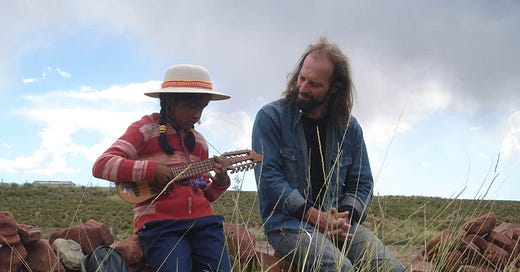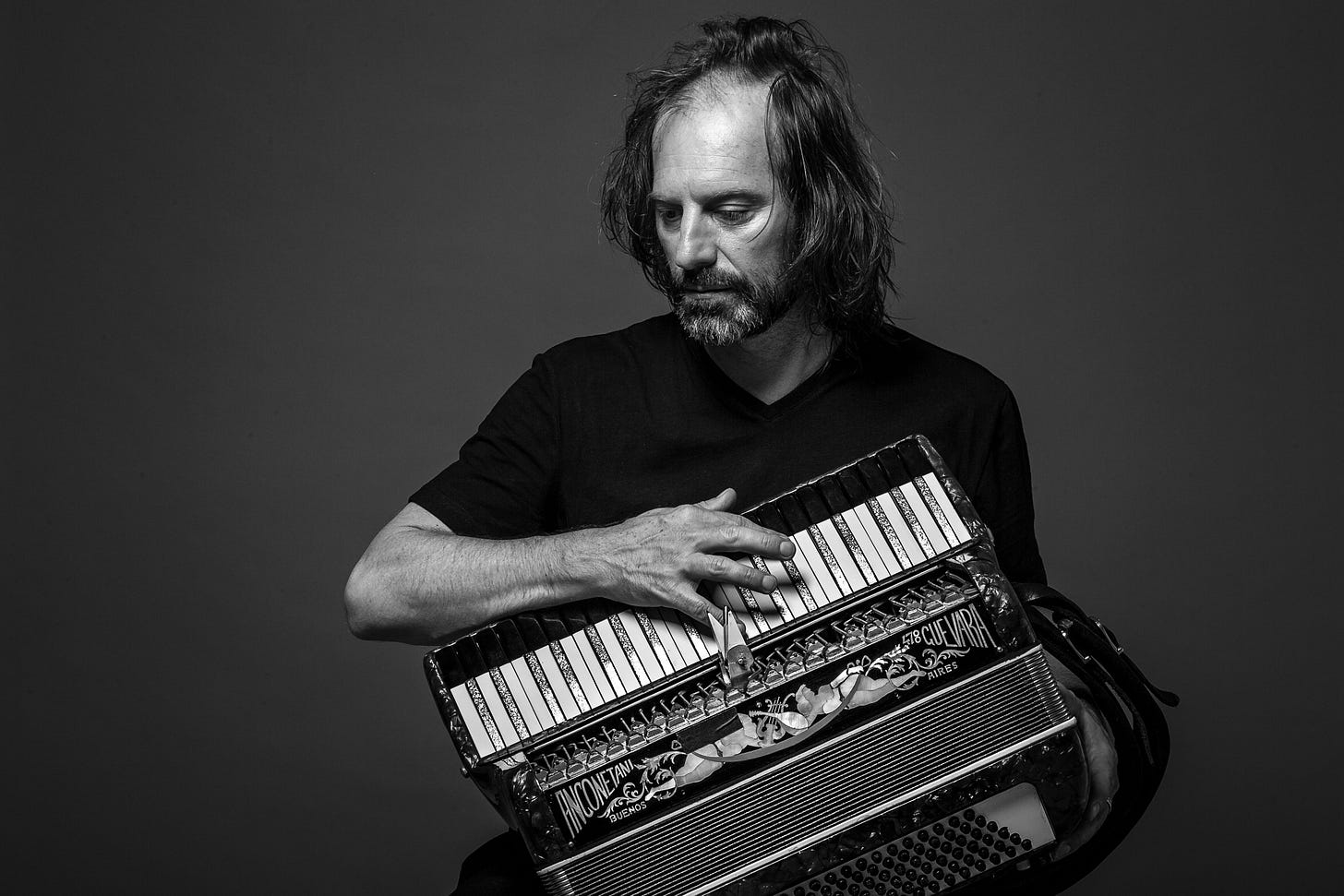Wherever European expatriates landed in the Americas, the accordion often followed, as in northeastern Argentina, where accordionist-composer Horacio Eugenio “Chango” Spasiuk’s Ukrainian grandparents immigrated in the late 19th century.
Misiones Province, far from Buenos Aires in the borderlands with Paraguay and Brazil, an area first colonized by Jesuit missionaries, the music that would evolve drew upon liturgical choir, Spanish and Portuguese guitar, classical strings, accordion, bandoneón, and piano of Eastern European immigrant folk traditions, African percussion, and the songs of the native Guaraní people.
The result is a music known as chamamé, a genre quite different from tango. First described in the 19th-century accounts, chamamé is a lyrical 6/8 social dance form. But as with other genres whose development preceded recording technology, little is known about its evolution prior to the first chamamé 78–RPMs tracked by RCA in 1930s Buenos Aires. In 2020, chamamé was inscribed in UNESCO’s Intangible Cultural Heritage list.
Over a career spanning nearly 35 years, Chango Spasiuk has become a distinguished chamamé exponent, and a scholar of folk traditions from Argentina, Paraguay, Bolivia, Uruguay, and Brazil. A Latin Grammy nominee, he is host of the Argentine public TV program “Pequeños Universos,” and winner of Premios Martín Fierro, Premios Carlos Gardel, and the BBC Radio 3 World Music Awards.
Spasiuk tours widely and has appeared at venues including the Montreal International Jazz Festival, Toronto Ukrainian Festival, Carnegie Hall, Festival Internacional Cervantino (Cuernavaca, Mexico), WOMAD, Celtic Connections (Glasgow), Montreux Jazz, Haus del Kulturen der Welt (Berlin), Fira Mediterrània de Manresa (Catalunya, Spain), and Babel Med Music (Marseille) among many others.
I first saw Chango perform at Nuremberg’s Bardentreffen Festival in 2002, and when the opportunity later arose, produced his combo in concert at Princeton University’s Richardson Auditorium. Many years later, people who were present still recall being spellbound with the meditative spirit Chango and crew conjured that evening.
This is a case where live performance has it all over any recorded artifact (see the video below). In any case, Eiké captures the brilliant heart and soul of the music. Eiké is a Guaraní word signifying a social invitation into a soulful open space, reference to the recording’s origin during the enforced isolation of COVID. It also represents a newer experimental phase in Chango’s global artistic trajectory, soliciting contributions from fellow artists in Argentina (Gustavo Santaolalla, ronroco-charango; Sergio Tarnoski, accordion; Marcelo Dellamea, guitar), Brazil (Jaques Morelenbaum, cello), Paraguay (Sixto Corbalán, harp), Spain (Carlos Núñez, Galician flute), France (Erik Truffaz, trumpet), Norway (Einar Watle, guitar; Steinar Raknes, contrabass), Morocco (Majid Bekkas, oud), and Senegal (Boubacar Cissokho, kora).
Along with nine originals (including an unexpected piano solo, “Improvisación para Juana”), Chango reinterprets three chamamé classics by Isaco Abitbol (“Siete Higueras,” seven daydreams), Luis Angel Monzón (“Puestero Lobizón,” the werewolf ranch hand of Guaraní mythology), and Heraclio Pérez (“Puerto Tirol,” a Chaco Province town founded in the 1880s by South Tyrolean immigrants).
Of his work, Chango remarks,
Chamamé is a prayer that dances. The accordion is a very physical instrument, and if you play with a lot of energy, the body soon starts to move without thinking. When the audience stops thinking and starts to feel, then they begin to understand what this music is about. I am not trying to be a virtuoso. What interests me is the music, and the ideas and feelings it carries. More than simple entertainment, it tends to a reflective, introspective space. Fundamentally I am a bit conservative when it comes to sustaining its formality, its sobriety, its spontaneity, and the connection it can evoke with the audience.
Possessed of an entranced — and entrancing — stage presence, Chango Spasiuk and his artistic collaborators summon an atmospheric music of profound serenity, beauty, and feeling. Articulating a dark melancholy, so much a part of Argentine history, his work sustains a tragic sense of hope and longing before the impermanence of all human endeavors.
Find the artist: changospasiuk.com






This is entrancing. Keep the music coming.
"A prayer that dances..."